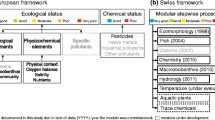Abstract
Due to a fast decline in the ecological quality of watercourses combined with the threat of human functions, policy makers started to legislate water quality objectives for watercourses and to set up water purification programs. The description of universal quality objectives is too limited as a frame of reference and a policy only based on water quality cannot guarantee the goals of river restoration as a whole. In most countries the need for a more integrated approach of water management is growing. Water quantity must be managed together with water quality, surface water with groundwater, and the water economy with town and country planning.
To restore and maintain the natural diversity of watercourses, together with the natural species richness, policy makers need a frame of reference based on the natural functioning of the ecosystem. The highest level of reference is called the ‘ecological naturalness’. Based on the present and the potential ecological value and on the intensity of human uses, policy makers together with a group of scientists should decide on the ecological quality objectives of watercourses. The lowest quality level that must be reached in all watercourses can be described as the ‘ecological basic quality’. Together with a frame of reference, there is a need for a refined ecological evaluation method for ecological quality as a whole, and especially to evaluate ‘potential ecological values’ in an objective way.
Similar content being viewed by others
References
Anon., 1987. Our Common Future. World Commission on Environment and Development. Oxford Univ. Press, Oxford.
Anon., 1989. Water voor nu en later, Derde Nota Waterhuishouding. Ministerie van Verkeer en Waterstaat. SDU-drukkerij, Nederland. 68 pp.
Anon., 1991. Rivierbekkenbeleid in Vlaanderen. Ministerie van de Vlaamse Gemeenschap, Departement Leefmilieu en Infrastructuur — Administratie Milieu, Natuur en Landinrichting, Bestuur Algemeen Milieubeleid. 57 pp.
Ant, H., H. J. Bauer, G. Friedrich, R. Hedtstück, K. Limpert, W. Pflug, R. Pott, K. Reschke, W. Schiller, H. H. Söhngen & E. Stähr, 1985. Bewertung des ökologischen Zustandes von FließLgewässern. Landesanstalt für ökologie, Landschaftsentwickelung und Forstplanung NW, Recklinghausen — Landesamt für Wasser und abfall NW, Düsseldorf, Woeste-Druck Verlag, Essen. 65pp.
Bervoets, L. & A. Schneiders, 1989. Onderzoek naar de verspreiding en de typologie van ecologisch waardevolle waterlopen in het Vlaamse Gewest. Algemene methodologie. Ministerie van de Vlaamse Gemeenschap, AROL (Administratie Ruimtelijke Ordening en Leefmilieu), Bestuur Leefmilieu, Dienst Water- en Bodembeleid. 20 pp.
Bruylants, B., A. Vandelannoote & R. F. Verheyen, 1989. De vissen van onze Vlaamse beken en rivieren, hun ecologie, verspreiding en bescherming. WEL v.z.w., Antwerpen. 272 pp.
De Lange, L. & M. A.De Ruiter, 1977. Biologische waterbeoordeling. Hoofdstuk 4: Beoordeling van de waterkwaliteit op basis van het macrofytenbestand. Werkgroep Biologische Waterbeoordeling, Instituut voor Milieuhygiëne en Gezondheidstechniek, TNO, Delft. pp. 90–113.
De Lyon, M. J. H. & J. G. M. Roelofs, 1986. Waterplanten in relatie tot waterkwaliteit en bodemgesteldheid. Ministerie van Landbouw en Visserij, Landinrichtingsdienst, Katholieke Univ. Nijmegen. 106 pp.
Gardiner, J., 1989. The National Rivers Authority, note Thames Water Authority.
Gielis, R., 1987. Ruilverkaveling Poppel. Evaluatie van twee planalternatieven, deel 5: Effecten op het landschap, landschapsecologische benadering. Rapport Nationale Landmaatschappij.
Haslam, S. M., 1978. The Macrophytic Vegetation of Watercourses, Cambridge Univ. Press, Cambridge. 396 pp.
Haslam, S. M., 1987. River Plants of Western Europe. The Macrophytic Vegetation of Watercourses of the European Economic Community. Cambridge Univ. Press, Cambridge. 512 pp.
Holmes, N. T. H., 1983. Typing British rivers according to their flora. Focus on nature conservation no. 4. Nature Conservancy Council, Shrewsbury.
Johnson, S. P. & G. Corcelle, 1989. The Environmental Policy of the European Communities. International Environmental Law and Policy Series. Graham and Trotman, Kluwer Academic Publishers Group. 349 pp.
Karr, J. R., 1991. Biological Integrity: A long-neglected aspect of water resource management. Ecol. Applic. 1(1): 66–84.
Lewis, G. & G. Williams, 1984. Rivers and wildlife handbook: a guide to practices which further the conservation of wildlife on rivers. Roy. Soc. Protect. Birds, and Roy. Soc. Nature Conserv. 295 pp.
Logemann, D. & E. F. Choorl, 1988. Verbindingswegen voor plant en dier, Reeks Natuur en Milieu, nr. 23. Uitgave Stichting Natuur en Milieu, Utrecht/Amsterdam. 75 pp.
Metcalfe, J., 1989. Biological water quality assessment of running waters, based on macroinvertebrate communities: history and present state in Europe. Environ. Pollut. 60: 11–139.
Peeters, E. T. H. M. & J. J. P. Gardeniers, 1992. Ecologisch beoordelingssysteem stromend water. Concept Eindverslag versie 4, maart 1992. Vakgroep Natuurbeheer Landbouwuniversiteit Wageningen. 59 pp.
Schneiders, A. & C. Wils, 1991. Onderzoek naar de verspreiding en de typologie van ecologisch waardevolle waterlopen in het Vlaamse Gewest: het Dijlebekken. Ministerie van de Vlaamse Gemeenschap — AMINAL, Bestuur Algemeen Milieubeleid, Dienst Water en Bodem.
Schneiders, A., E. Verhaert, L. Bervoets, J. Coeck & R. F. Verheyen, 1990. Ekologische kwaliteitsdoelstellingen voor waterlopen. Water nr. 50: 58–65.
Ter Brink, B. J. E. & S. H. Hosper, 1989. Naar toetsbare ecologische doelstellingen voor het waterbeheer: de AMOEBE-benadering. H2O 22(20): 12–17.
Van Katwijk, M. M. & J. G. M. Roelofs, 1988. Vegetaties van waterplanten in relatie tot het milieu. Ministerie van Landbouw en Visserij, Landinrichtingsdienst. Katholieke Univ. Nijmegen. 133 pp.
Verhaert, E. 1980. Het verband tussen het voorkomen van hogere planten en vervuiling in laaglandbeken behorende tot het bekken van de Kleine Nete. Licentiaatsver-handeling, Univ. Antwerp, Dep. Biol. 77 pp.
Verhaert, E., A. Schneiders, G.De Blust, L. Bervoets, J. Coeck & R. F. Verheyen, 1990. Integraal Waterbeheer. Ruimtelijke planning 24, II.G.1.a.: 1–25.
Author information
Authors and Affiliations
Rights and permissions
About this article
Cite this article
Schneiders, A., Verhaert, E., Blust, G.D. et al. Towards an ecological assessment of watercourses. J Aquat Ecosyst Stress Recov 2, 29–38 (1993). https://doi.org/10.1007/BF00043332
Issue Date:
DOI: https://doi.org/10.1007/BF00043332




